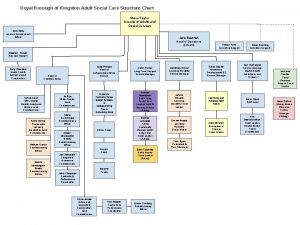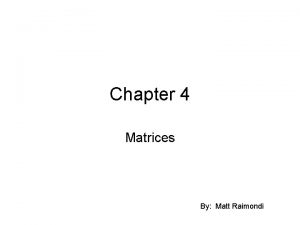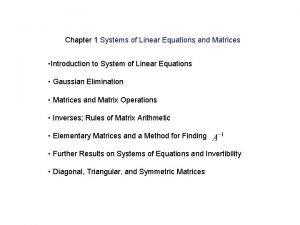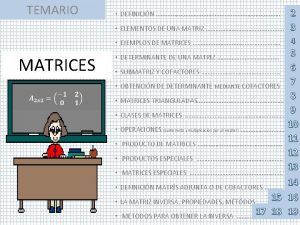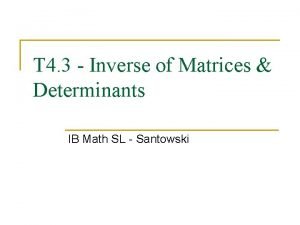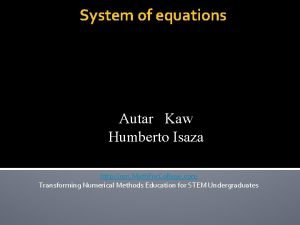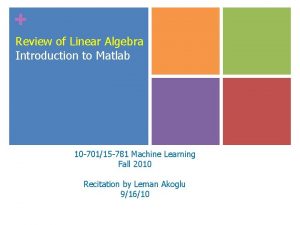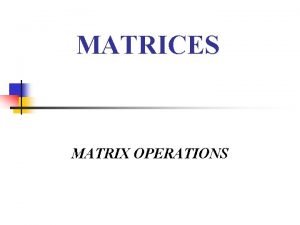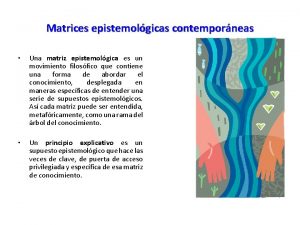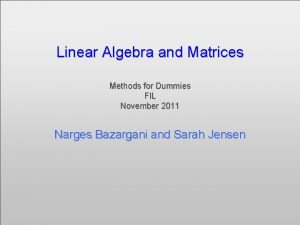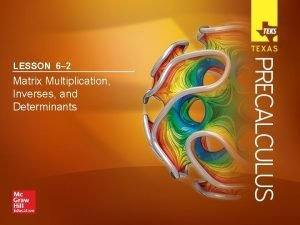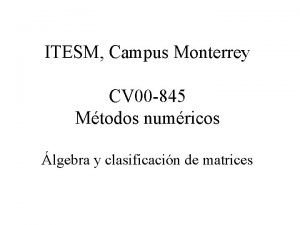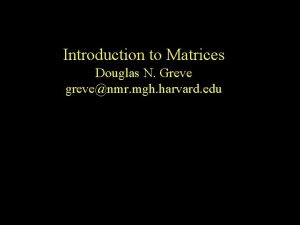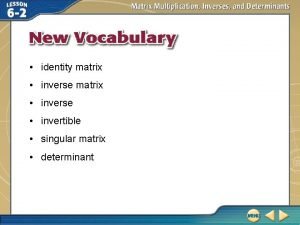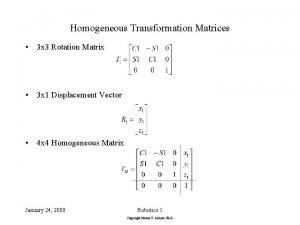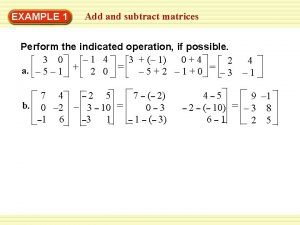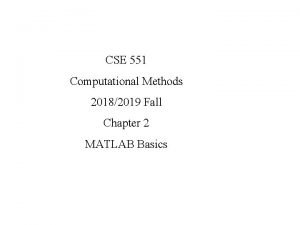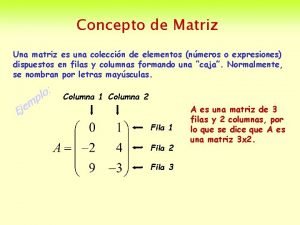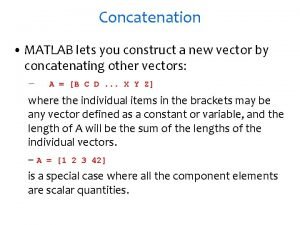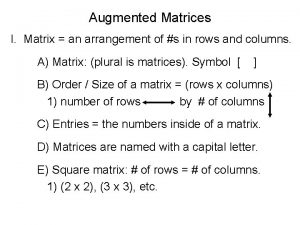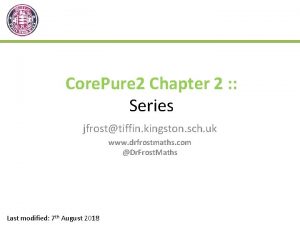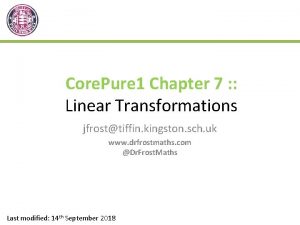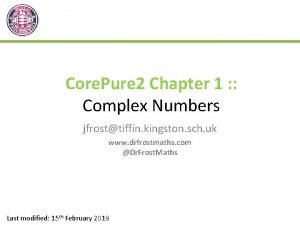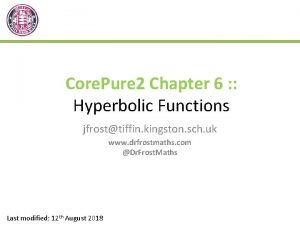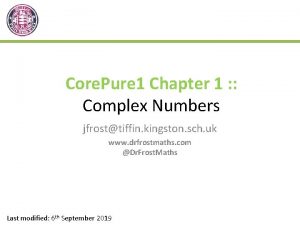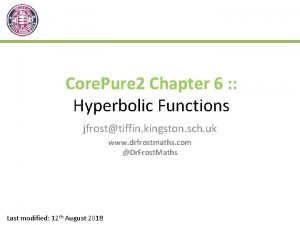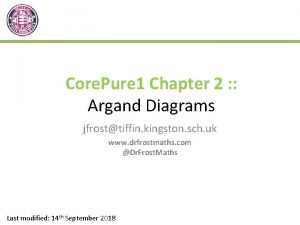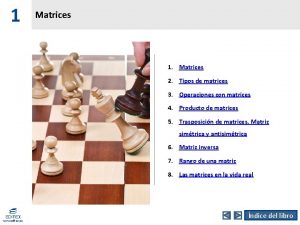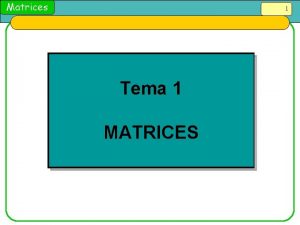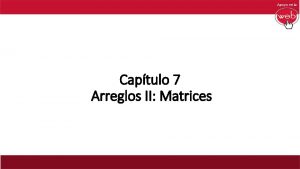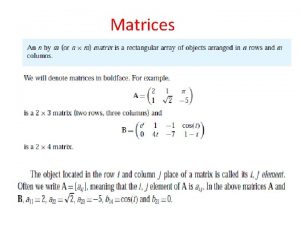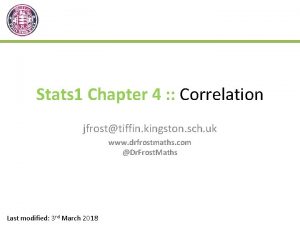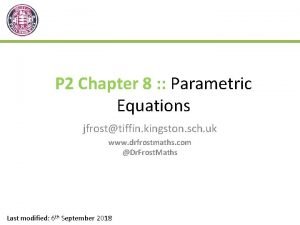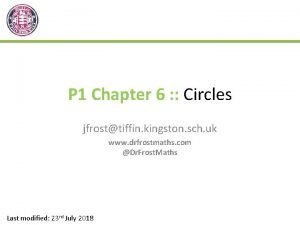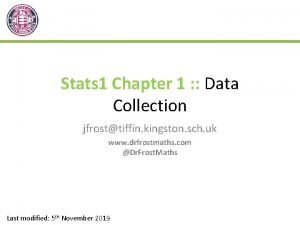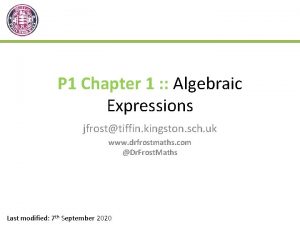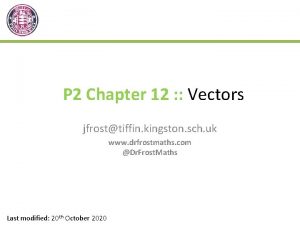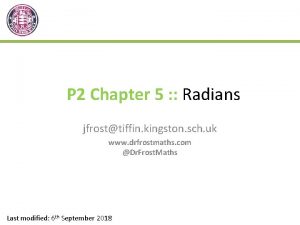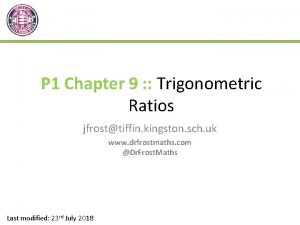Core Pure 1 Chapter 6 Matrices jfrosttiffin kingston








































![Forming the equations yourself [Textbook] A colony of 1000 mole-rats is made up of Forming the equations yourself [Textbook] A colony of 1000 mole-rats is made up of](https://slidetodoc.com/presentation_image_h/9d06eeef0c7430d597ea245813d00234/image-41.jpg)







- Slides: 48

Core. Pure 1 Chapter 6 : : Matrices jfrost@tiffin. kingston. sch. uk www. drfrostmaths. com @Dr. Frost. Maths Last modified: 14 th September 2018

www. drfrostmaths. com Everything is completely free. Why not register? Register now to interactively practise questions on this topic, including past paper questions and extension questions (including MAT + UKMT). Teachers: you can create student accounts (or students can register themselves), to set work, monitor progress and even create worksheets. With questions by: Dashboard with points, trophies, notifications and student progress. Questions organised by topic, difficulty and past paper. Teaching videos with topic tests to check understanding.

Chapter Overview Those who have done either IGCSE Further Mathematics would have encountered some of this content. Otherwise it will be completely new! 2: : Multiply Matrices 1: : Understand matrices and perform basic operations (adding, scalar multiplication) 3: : Find the determinant or inverse of a matrix. 4: : Solve simultaneous equations using matrices.

Introduction A matrix (plural: matrices) is simply an ‘array’ of numbers, e. g. On a simple level, a matrix is just a way to organise values into rows and columns, and represent these multiple values as a single structure. But the power of matrices comes from them representing linear transformations/functions (which we will particularly see in Chapter 7). We can 1. Represent linear transformations using matrices (e. g. rotations, reflections and enlargements) 2. Use them to solve linear simultaneous equations. Matrices are particularly useful in 3 D graphics, as matrices can be used to carry out rotations/enlargements (useful for changing the camera angle) or project into a 2 D ‘viewing’ plane.

(Just for Fun) Using matrices to represent data This is a scene from the film Good Will? Hunting. Maths professor Lambeau poses a “difficult”* problem for his graduate students from algebraic graph theory, the first part asking for a matrix representation of this graph. Matt Damon anonymously solves the problem while on a cleaning shift. * It really isn’t. ?

(Just for Fun) Using matrices to represent data In my 4 th year undergraduate dissertation, I used matrices to help ‘learn’ mark schemes from GCSE biology scripts*. Matrix algebra helped me to initially determine how words (and more complex semantic information) tended to occur together with other words. * Shameless Brag Opportunity: I won the “Best Undergraduate Dissertation Prize” for this!

(Just for Fun) And matrices in Statistics… In Stats Year 2, you have/will come across the Normal Distribution, where you need to specify the variance. This can be extended to 2 D (and beyond) by using a “covariance matrix”, where each number in the matrix gives the extent to which each axis varies with each other. 1 D 2 D

Matrix Fundamentals #1 Dimensions of Matrices The dimension of a matrix is its size, in terms of its number of rows and columns (in that order). Matrix Dimensions ? ?

Matrix Fundamentals #2 Notation/Names for Matrices A matrix can have square or curvy brackets*. Matrix Column Vector Row Vector A matrix with one column is simply a vector in the usual sense! * The textbook only uses curvy.

Matrix Fundamentals #3 Variables for Matrices If the value of a variable is a matrix, we use bold, capital letters (In contrast, vectors use bold, lowercase letters)

Matrix Fundamentals #4 Adding/Subtracting Matrices Simply add/subtract the corresponding elements of each matrix. They must be of the same dimension. ? ?

Matrix Fundamentals #5 Scalar Multiplication A scalar is a number which can ‘scale’ the elements inside a matrix. 1 2 3 ? ? ?

Matrix Fundamentals #6 Special Matrices A matrix is square if it has the same number of rows as columns. A zero matrix is one in which all its elements are 0. The dimensions are usually clear from the context. We will see the significance of the identity matrix when we cover matrix multiplication imminently.

Exercise 6 A Pearson Pure Mathematics Year 1/AS Pages 97 -99 (Classes in a rush could probably get away with skipping this exercise)

Matrix Multiplication Now repeat the process with the first row and second column. Now repeat for the next row of the left matrix. . . 1 0 3 -2 2 8 4 3 7 -1 0 2 5 1 1 7 0 3 8 -3 -11 42 16 61 50 -6


Test Your Understanding a b c ? ? ? N 2 N 3 N 1 ? ? ?

Matrix Fundamentals #7 Matrix Multiplication Matrix multiplications are not always valid: the dimensions have to agree. 2 3 3 4 2 4 1 3 2 3 Not valid. 6 2 2 4 6 4 1 3 3 1 1 1 7 5 Not valid. 10 10 9 3 3 ? ? ? ? Note that only square matrices (i. e. same width as height) can be raised to a power.

Exercise 6 B Pearson Pure Mathematics Year 1/AS Pages 101 -103

Determinant of a matrix In Chapter 7, you will see that matrices can be thought of as a function that can transform a point, eg: A question might naturally be whethere is an ‘inverse function/transformation’ that can retrieve the original point:

Determinants Quickfire Questions: 1 ? -2 ? 3 ? -2 ?

Test Your Understanding So Far ? Edexcel FP 1(Old) Jan 2010 Q 5 ? ?

(note the minus for the middle one) ?

Test Your Understanding ? ?

Minors ? ? ?

Exercise 6 C Pearson Pure Mathematics Year 1/AS Pages 106 -108


Practising the Inverse Divide by determinant. Swap NW-SE elements. Click to Froinverse Make SW-NE elements negative.

Test Your Understanding ? ? ? ? ?

Matrix Proofs Involving Inverse ? ? Exam Note: I couldn’t find any (old spec) FP 1 questions of this type.

Exercise 6 D Pearson Pure Mathematics Year 1/AS Pages 110 -111

Matrix Transpose (Far beyond understanding required for exam)

The method we previously used was a specific case of a more general method which can be used for matrices of any size: Recap: The minor of each element in a matrix is the determinant of the remaining matrix when the row and column are crossed out. ? A cofactor by definition is ‘a signed minor’. We simply apply signs to each minor using the following alternating pattern: (+ top left) ?

? Fro Tip: Note we’ve already found the top row from above. ? ? ?

Doing with your Classwiz

Further Example a ? b ?

Test Your Understanding ? ?

Exercise 6 E Pearson Pure Mathematics Year 1/AS Pages 115 -116

Frost Life Stories. TM In the game Assassin’s Creed II, you encounter a variety of concentric ring picture puzzles, which upon successfully completing, you unlock a segment of a secret video. Rings are connected in pairs, and must be rotated together in their pairs. The aim is to form a complete picture. Different possible pairs can be selected, for example, where there just 3 rings, you could rotate A and B together, B and C together or C and A together. Only certain pairings are available. Because I got stuck on one (this was back in my uni days) and because I’m incredibly uncool, I formed simultaneous equations and used a matrix inverse to solve them, which therefore told me how many times to rotate each pair. We’ll see how we can do this.

Using Matrices For Simultaneous Equations If we multiplied out the LHS it’s easy to see this gives us the equations in the original question. ? Use your calculator to find this directly. ? ? Calculator Tip: You could check your answer using the simultaneous equation solver.
![Forming the equations yourself Textbook A colony of 1000 molerats is made up of Forming the equations yourself [Textbook] A colony of 1000 mole-rats is made up of](https://slidetodoc.com/presentation_image_h/9d06eeef0c7430d597ea245813d00234/image-41.jpg)
Forming the equations yourself [Textbook] A colony of 1000 mole-rats is made up of adult males, adult females and youngsters. Originally there were 100 more adult females than adult males. After one year: • The number of adult males had increased by 2% • The number of adult females had increased by 3% • The number of youngsters had decreased by 4% • The total number of mole-rats had decreased by 20 Form and solve a matrix equation to find out how many of each type of mole-rat were in the original colony. “ 1000 mole-rats” ? ? ? “Originally 100 more adult females than adult males” “Total mole-rats after 1 year decreased by 20. ” ?

Consistency of linear equations From Pure Year 1 you are already familiar with the idea that the solution of a system of two equations (with two unknowns) can be visualised by finding the point of intersection of two lines. A system of linear equations is known as consistent if there is at least one set of values that satisfies all the equations simultaneously (i. e. at least one point of intersection).

Extending consistency to 3 variables Scenario 1: Planes all meet at a single point. System of equations consistent, and one solution. Scenario 2: Planes form a sheaf. They have a line of intersection consisting of infinitely many points. System of equations consistent and infinitely many solutions. Scenario 3: Planes form a prism. While planes intersect in pairs, they don’t all intersect at any point. System of equations is inconsistent. Scenario 4: Two of more planes parallel and non-identical. Again, inconsistent, as the parallel planes never intersect, and thus all equations can’t be satisfied. Any rows in the corresponding matrix which are multiples of each other will be parallel.

Extending consistency to 3 variables Scenario 5: Planes represented by equations are equivalent. System of equations consistent, and infinitely many solutions.

Example Remember that the system of equations is consistent if the corresponding matrix is non-singular, i. e. its determinant is non-0. a ?

Example b ? If the matrix is singular, the system of equations could still be consistent: recall that we might have a sheaf (i. e. planes intersect at a line) or equations represent same plane. Eliminate one of the variables. If resulting two equations are consistent, then system will be consistent.

Test Your Understanding ?

Exercise 6 F Pearson Pure Mathematics Year 1/AS Pages 120 -121
 Aquajet kingston
Aquajet kingston Adult social care kingston
Adult social care kingston Kingston road traffic
Kingston road traffic Professor margaret kingston
Professor margaret kingston Jps ecommerce kingston 5
Jps ecommerce kingston 5 Prawy hals pierwszeństwo
Prawy hals pierwszeństwo Joseph lawrence chung mei
Joseph lawrence chung mei Martin kingston qc
Martin kingston qc Kingston strategic partnership
Kingston strategic partnership Fass loans kingston
Fass loans kingston Kingston planning scheme
Kingston planning scheme Matt raimondi
Matt raimondi Homogeneous system of linear equations examples
Homogeneous system of linear equations examples Inner core and outer core
Inner core and outer core Crust mantle core
Crust mantle core Which layer is the least dense
Which layer is the least dense Core rigidities
Core rigidities Properties of pure substance
Properties of pure substance Matrice progresive raven
Matrice progresive raven Cuando una matriz es idempotente
Cuando una matriz es idempotente Determinant matrice 3x3
Determinant matrice 3x3 Can matrices be divided
Can matrices be divided Linear independence matlab
Linear independence matlab Woodcock-johnson test sample
Woodcock-johnson test sample Stan grof perinatal matrices
Stan grof perinatal matrices Matriz opuesta
Matriz opuesta Operaciones con matrices
Operaciones con matrices Matrix of equations
Matrix of equations Ivory no 1 retainer parts
Ivory no 1 retainer parts 2x3 matrix
2x3 matrix Boolean powers of zero-one matrices
Boolean powers of zero-one matrices Matrices epistemologicas
Matrices epistemologicas Linear combination
Linear combination Matrix for dummies
Matrix for dummies 3 by 3 matrix
3 by 3 matrix Les matrices marketing
Les matrices marketing Clasificacion de matrices
Clasificacion de matrices Upper triangular matrix 3x4
Upper triangular matrix 3x4 Singular matrix
Singular matrix Homogeneous transform matrix
Homogeneous transform matrix Subtract matrices calculator
Subtract matrices calculator Division de matrices 3x3
Division de matrices 3x3 Rango de una matriz
Rango de una matriz Concatenate matlab
Concatenate matlab Condition for no solution in determinant
Condition for no solution in determinant Augmented matrix
Augmented matrix Cuadro comparativo de matrices
Cuadro comparativo de matrices Aplicacion de estructuras de datos vectores y matrices
Aplicacion de estructuras de datos vectores y matrices Applications of matrices and determinants
Applications of matrices and determinants

